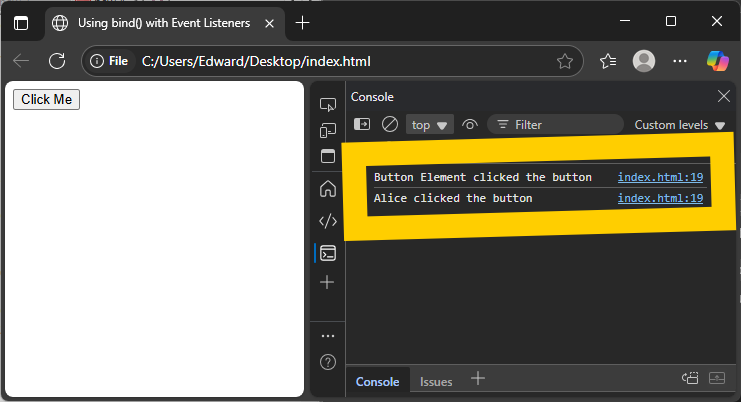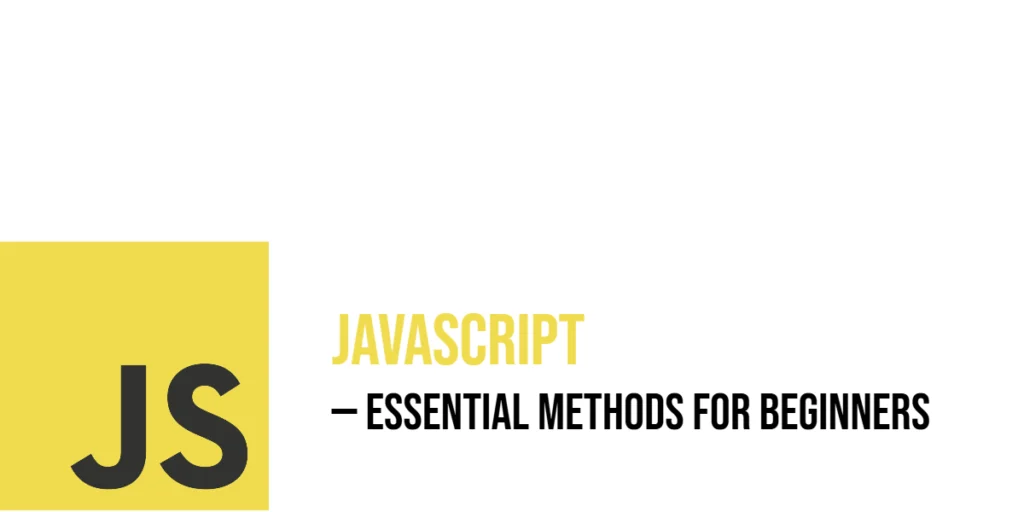The JavaScript bind() method creates a new function that has its this keyword set to a specific value. This helps control what this refers to when the function runs.

with hands-on learning.
get the skills and confidence to land your next move.
The goal of this article is to show you how to use the bind() method to fix the value of this in functions. This is especially useful when passing object methods as callbacks, where a common problem called “losing this” happens — meaning the method loses its connection to the original object.
What is bind() Method?
The bind() method creates a new function with the this keyword set to the value you provide. This means you can control what this points to inside the function.
Unlike calling a function, bind() does not run the function right away. Instead, it returns a new function that you can call later, with the fixed this value.
Basic Syntax
The syntax for bind() looks like this:
let boundFunction = originalFunction.bind(thisArg, arg1, arg2, ...);Here’s what the parts mean:
thisArg— The value you want to fix asthisinside the new function.arg1, arg2, ...— Optional arguments you can preset. These arguments will be passed before any others when you call the bound function later.
Simple Example: Binding this
Here’s a simple example showing how this can change, and how bind() method fixes it:
const dog = {
name: "Kol",
speak() {
console.log(this.name + " says Woof!");
}
};
const speakFunction = dog.speak;
speakFunction(); // undefined says Woof!
const boundSpeak = dog.speak.bind(dog);
boundSpeak(); // Kol says Woof!In this example, when we save the method dog.speak to speakFunction and call it alone, this is lost and becomes undefined (or the global object), so it prints "undefined says Woof!".
Using bind(dog) creates a new function where this always refers to the dog object. So, boundSpeak() correctly logs "Kol says Woof!".
This shows how bind() method locks the this value for functions, fixing common issues when methods are passed around.
Binding with Arguments
You can use bind() not just to fix this, but also to preset some function arguments.
function greet(greeting, punctuation) {
console.log(greeting + ", " + this.name + punctuation);
}
const person = { name: "Lucy" };
const greetLucy = greet.bind(person, "Hello");
greetLucy("!");In this example, the first argument of bind sets this to the person object. The next argument "Hello" is pre-set as the first parameter (greeting) for the function.
When you call greetLucy("!"), it uses "Hello" as the greeting and "!" as the punctuation, printing "Hello, Lucy!".
So, bind() lets you fix this and lock in some arguments ahead of time, making your functions more flexible.
Using bind() Method with Event Listeners
When you add event listeners in JavaScript, the value of this inside the handler usually points to the HTML element that triggered the event. But sometimes, you want this to refer to a specific object instead.
You can use bind() method to fix this. It creates a new function where this is set to the object you want. Here’s an example showing how to use bind() with event listeners:
<!DOCTYPE html>
<html lang="en">
<head>
<meta charset="UTF-8" />
<title>Using bind() with Event Listeners</title>
</head>
<body>
<button name="Button Element">Click Me</button>
<script>
const button = document.querySelector("button");
const user = {
name: "Alice",
click() {
console.log(this.name + " clicked the button");
}
};
// Without bind(), 'this' inside click() would be the button element
button.addEventListener("click", user.click);
// Using bind(user) fixes 'this' to the user object
button.addEventListener("click", user.click.bind(user));
</script>
</body>
</html>In this example, when you click the button, two messages will appear in the console.
The first message comes from the event listener without bind(). Here, this refers to the button element itself, so it logs "Button Element clicked" using the button’s name attribute.
The second message comes from the event listener that uses bind(user). This ensures that this inside the click method refers to the user object, so it logs "Alice clicked the button".

Without bind(), this.name points to the button’s name, not the user’s name, which can cause unexpected results. Using bind() helps keep this bound to the object you want inside event handlers.
Partial Application with bind() Method
bind() can create new functions by pre-setting some arguments, leaving the rest to be given later. This is called partial application.
function multiply(a, b) {
return a * b;
}
const double = multiply.bind(null, 2);
console.log(double(5)); // 10Here, null is used because we don’t need to bind this (it’s not used in the function). The first argument 2 is fixed, so calling double(5) multiplies 2 by 5, returning 10.
Here’s another example showing partial application with more than one argument preset:
function createGreeting(greeting, name, punctuation) {
return greeting + ", " + name + punctuation;
}
const sayHelloTo = createGreeting.bind(null, "Hello", "Kol");
console.log(sayHelloTo("!")); // Hello, Kol!In this example, the first two arguments "Hello" and "Kol" are fixed using bind(). When you call sayHelloTo("!"), it adds the punctuation and returns the full greeting. This shows how you can pre-set multiple arguments with bind().
bind() Method vs Calling Functions Directly
This section shows the difference between calling a regular function and calling a function bound with bind().
const person = { name: "Bob" };
function sayName() {
console.log(this.name);
}
sayName(); // undefined
const boundSayName = sayName.bind(person);
boundSayName(); // BobWhen you call sayName() normally, this is not set to person, so it logs undefined. Using bind(person) creates a new function where this is permanently set to person. So calling boundSayName() prints "Bob". This shows how bind() fixes the value of this for the new function.
bind() vs call() vs apply()
In JavaScript, bind(), call(), and apply() all let you set the value of this when running a function. But they work in different ways:
bind()returns a new function withthisfixed to the value you provide. You can call this new function later.call()andapply()call the function immediately, using thethisvalue you give. The main difference betweencall()andapply()is how you pass arguments.call()takes arguments separately, whileapply()takes arguments as an array.
Here’s a quick comparison:
| Method | What it does | When it runs | How to pass arguments |
|---|---|---|---|
bind() | Returns a new function with fixed this | Later (when you call) | As separate values: arg1, arg2 |
call() | Calls the function immediately with this | Right away | As separate values: arg1, arg2 |
apply() | Calls the function immediately with this | Right away | As an array: [arg1, arg2] |
Example: Using bind(), call(), and apply()
Here’s an example to show how each one works in practice:
function say(greeting, punctuation) {
console.log(greeting + ", " + this.name + punctuation);
}
const person = { name: "Harry" };
// bind() creates a new function you can call later
const sayHello = say.bind(person, "Hello");
sayHello("!"); // Output: Hello, Harry!
// call() calls the function right away with separate arguments
say.call(person, "Hi", "!"); // Output: Hi, Harry!
// apply() calls the function right away with arguments in an array
say.apply(person, ["Hey", "!"]); // Output: Hey, Harry!Conclusion
The JavaScript bind() method creates a new function that has a fixed this value. It can also preset arguments that the function will use when called. This method is very useful to control the context (this) in your functions, especially when passing them around as callbacks or event handlers. With bind(), you ensure your functions always run with the right object, making your code more predictable and easier to manage.
References
- MDN Web Docs – Function.prototype.bind
Comprehensive guide and official documentation explaining howbind()method works in JavaScript, with detailed examples. - JavaScript.info – Function binding
Clear and practical explanation of thebind()method, including use cases and simple code samples to understand context binding.







